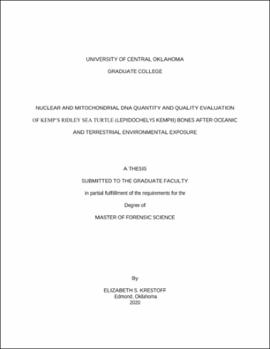| dc.description.abstract | Molecular biology techniques for the analysis of nuclear and mitochondrial DNA are routinely used to make species identifications in wildlife forensic science. Species identification is crucial to wildlife forensic science casework, as organisms or parts of organisms must be definitively identified prior to prosecution of the suspect(s). Unfortunately, wildlife remains are not typically discovered in a timely manner, which prolongs the exposure of the organism's DNA to damaging environmental factors. Regardless, it is essential to be able to identify which species the remains are from, such as in forensic investigations regarding sea turtle remains. Kemp's ridley sea turtles(Lepidochelys kempii) are critically endangered and are closely related to olive ridleys, a vulnerable species, thus it is especially important to distinguish between these two species even when only skeletal remains are discovered. Bone demineralization typically employs Proteinase K (Pro K) and EDTA to lyse skeletal osteons and release cortical DNA. However, sea turtle bones are more cartilaginous than terrestrial vertebrates. I tested the effectiveness of Collagenase Type II (CTII) against Pro K over a three-year exposure time series using two species, Kemp's ridley sea turtles and domestic cattle (Bostaurus). Evidence had been found demonstrating the effectiveness and improved DNA quality of Collagenase Type II extractions using non-degraded human bone samples. I utilized the Epicentre MasterPure kit for DNA isolation and purification, in triplicate, for each sample. I quantified the samples with the Qubit system, before amplification with genus-specific nuclear primers and species-specific mitochondrial primers, in preparation for cycle sequencing. I was able to evaluate the overall effects supratidal and subtidal environments had on skeletal DNA degradation over a three-year period in both a terrestrial mammal as well as a marine reptile. Mitochondrial DNA (mtDNA) was detected and recovered after exposure to either supratidal or subtidal environments after 424 days in both species. The mtDNA was of high enough quality in both organisms after extraction to make species-specific identifications. After 424days, DNA recovery became inconsistent in the L. kempii samples exposed to subtidal conditions, with failed sequencing results at 664 days and 1152 days for the CTII samples. In the L. kempii supratidal samples, species identifications could still be made after 787 days. For the terrestrial mammal, mtDNA species-specific identifications could be made from the samples exposed to supratidal and subtidal environments after 1511 and 1152 days, respectively. Nuclear DNA (nuDNA) was only detected and amplified in the terrestrial B. taurus samples and was of high enough quality for genus-specific identifications after 787 days. Additionally, I determined that CTII is comparable to Pro K in most circumstances. However, Pro K produced statistically favorable results for L. kempii samples when comparing DNA quantities and while controlling for the effects of exposure length. Pro K also had statistically favorable results for B. taurus samples when comparing DNA quantities while controlling for the effects of location, as well as comparing DNA quality and while controlling for the effects of exposure length. DNA recovery for species identification of Kemp's ridley sea turtles is primarily affected by exposure length, rather than exposure to subtidal or supratidal environments and Pro K is as effective as CTII for mtDNA quantity and quality returns. | en_US |
